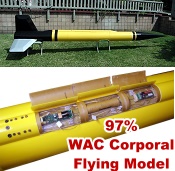|
May 1946 Popular Science
 [Table of Contents] [Table of Contents]
Wax nostalgic about and learn from the history of early
electronics. See articles from
Popular
Science, published 1872-2021. All copyrights hereby acknowledged.
|
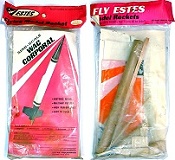
Vintage Estes WAC Corporal model rocket kit.
Prior to the
International Geophysical Year (aka IGY, which ended up running for a year and
a half), spanning from July 1, 1957, through December 31, 1958, not a lot was known
about the upper atmosphere. May 1946, when this article appeared in Popular Science
magazine, was less than a year after the end of World War II. During the war
a lot was learned about long distance wireless (radio) communications between and
across continents and ship to shore. Scientists theorized about the phenomenon of
charged particles at high altitudes which, being electrically conductive, could
reflect electromagnetic signals so that over the horizon signals could be exchanged.
Coincidence with sunspot activity and aurorae had already been established, but
more knowledge was needed. Rocket technology also developed during the war had matured
to where instruments could be launched tens of miles high into what came to be called
the ionosphere. The Army's WAC Corporal sounding rocket was one of the earlier platforms
for such work. Estes Industries made a flying scale model of the WAC Corporal (see
thumbnail), one of which I built and launched as a kid in the late 1960s and early
1970s. The Smithsonian Institution has a nicely restored
WAC Corporal on display.
50 Miles Up
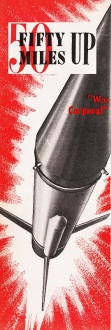 This Summer "Wac Corporal" Leads Assault
on Ionosphere to Increase Our Knowledge of Weather and Radios This Summer "Wac Corporal" Leads Assault
on Ionosphere to Increase Our Knowledge of Weather and Radios
By James L. H. Peck and Kenyon Kilbon
"Wac Corporal" is a slender rocket with an important research mission in the
ionosphere. She already has streaked to altitudes of nearly 50 miles above her base
at the White Sands Proving Ground, Las Cruces, N. M., to send back information from
the lower fringe of the ionized layers surrounding the earth.
This summer, the Corporal and her sisters, the Wac Sergeant and Wac Private,
are scheduled to zoom into the atmospheric desert lying from 35 to 500 miles above
us on voyages that may be as historic as those of Christopher Columbus's three tiny
ships in 1492. They will seek data needed to improve radio techniques, forecast
the weather, and solve riddles as ancient as human thought.
The Corporal is a half-ton cylinder built of steel, aluminum and magnesium. From
the tip of her needle-sharp nose, shaped to penetrate the shock waves that build
up at supersonic speeds, she stretches 16 feet 2 inches past three stabilizing fins
to the end of her rocket tube. Into her slim barrel, only 12 inches in diameter,
are packed radar and secret devices designed to gather and transmit data to the
base station during flight. These robots will be her only passengers when her masters
step back from the steel framework that holds her upright on a concrete base in
the desert and watch a flaming jet carry her into the unknown.
Scientists will send a great barrage of rockets into the upper layers of the
atmosphere within the next few months. In addition to the Wacs, they have other
highly secret projectiles, and plans call for the use of 25 reconstructed German
V-2s. One U. S rocket is reported to be able to reach the 80-milee level. The Wac
Corporal already has climbed to 230,000 feet - 43 1/2 miles - and the V-2 is said
to have reached heights of 60 to 75 miles over horizontal ranges of 200 or more
miles during its wartime missions. With its energy directed toward attaining absolute
altitude, V-2 may go higher.
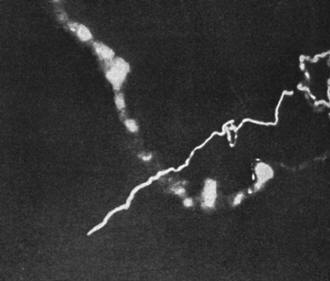
Though the "WAC Corporal" was roaring straight up when this picture
was taken by an Army newsreel cameraman at the New Mexico tests, its exhaust trail
looks erratic. That is because it was blown by varying winds at different altitudes.
Improved combustion chambers and fuel systems have been devised to fit the rockets
for their long-range research flights. Although the details of those actually in
use remain secret, patents recently granted to the late rocket-pioneer, Dr. Robert
H. Goddard, of Clark University and Roswell, N. M., bring sparkles to experts' eyes.
The patents cover a fuel system using gasoline and liquid oxygen, and a combustion
chamber that spins like a top as the fuel burns. The fuel system has a small tank
of liquid nitrogen enclosed in the oxygen container. The nitrogen is piped through
a coil around the combustion chamber as a coolant, returning it to a gaseous condition.
The gas is then piped to the gasoline tank, where it is used to maintain pressure
equilibrium as the gasoline is withdrawn. The spinning combustion chamber, mounted
in ball bearings, provides more rapid and efficient combustion.
Ingenious instruments and methods have been contrived, too, to speed data back
to earth from the rockets. Radar can track the projectiles at their supersonic speeds,
and sections of a rocket can be detached by radio control to parachute recording
instruments down. These will include ozone analyzers and versatile ionization meters
which gather facts about cosmic and ultraviolet radiation. Special glass-lined chambers
which open and reseal automatically have been built to bring back samples of the
upper atmosphere. Some of the rockets also may carry compact, wide-angle infrared
cameras to photograph the earth from extreme altitudes.
A few of the rockets may be destroyed by shattering collisions with meteors in
the rarefied upper air. From 75,000,000 to 10,000,000,000 meteors are believed to
enter the earth's atmosphere daily, at speeds as great as 180,000 miles an hour.
Most of them are eliminated by friction in the atmosphere before they strike the
earth, but a rocket penetrating to great heights runs the risk of encountering one
still massive enough to be destructive.
The evidence brought back by the rocket-borne instruments may affect many of
our theories and deductions about the earth's atmosphere. Scientists now picture
a series of adjoining layers surrounding the globe. They have designated the known
layers by the letters C through F, beginning at the earth's surface, allowance having
been made for the possible designation of additional levels below C or above F.
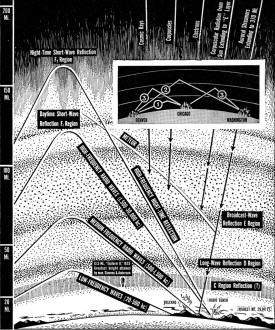
This cross-section drawing shows the layer-cake pattern of the
atmospheric regions girdling the earth. Using these layers of ionized air, radio
transmission becomes like an electronic game of three-cushion billiards in which
low-to-high-frequency waves are "banked" to points beyond the horizon (see inset)
- often halfway around the globe. "Wac Corporal" and other super-rockets will explore
the make-up of these regions.
The outer layers, D, E and F, show the effects of constant exposure to the bombardment
of ultraviolet radiations and charged particles from the sun, the stars and even
meteors. If it were not for the atmosphere, the intense radiation would extinguish
life on earth, but the coating of air filters and absorbs them to the point of safety.
In the process, however, the outer atmosphere takes on the peculiar characteristics
that identify the ionosphere.
When the ultraviolet light from the sun encounters the gaseous atoms of the outer
air, ionization takes place on a grand scale. The result is not an explosion such
as men have obtained from atomic fission, but a steady process of electron detachment
and recombination among the atoms of the rarefied atmosphere. Under the bombardment,
electrons are torn from their atoms, leaving the outer air filled with free electrons
and unstable atoms, or ions, which attract one another and tend to rejoin because
of their opposite charges. Where the atmosphere is rare, distances between atoms
are relatively great, and recombination does not take place as rapidly as in the
denser air of lower altitudes.
This vast ionized region was studied in-dependently in 1902 by an American and
a Briton, who found that it reflected radio waves transmitted from the earth. They
discovered that the waves, encountering the electrified fields far above the earth,
were refracted or bent around to return to earth again, perhaps at great distances
from the point of origin. In honor of the two scientists, the ionized region was
named the Kennelly-Heaviside Layer.
Later research disclosed that ionization in the upper air did not occur uniformly,
but in strata, with the upper layers more in-tensely ionized than those nearer the
earth. Radar−like "ionosphere recorders," capable of sending high-frequency radio
waves through the electrified regions, revealed the approximate depth of each of
the layers, and the present conception of the ionosphere resulted. The high-altitude
sounding rockets will bring back more accurate information.
If not already built, a super-rocket capable of reaching the topmost layer is
likely to be developed soon. Such a rocket, fired from a vertical launching rack,
will streak up to the C layer, from 20 to 35 miles above us. There it may encounter
a small amount of ionization, but it will not be in the true ionosphere until it
enters the D region, about 35 miles up. Flashing through D, which reaches on to
50 miles, the super-rocket will record ionization strong enough to reflect long-wave
radio transmissions of low frequency between 20 and 500 kilocycles during the daylight
hours when solar radiation is present. During the hours of darkness, the D layer
almost entirely disappears.
Above the D layer, the rocket will penetrate the E region, the original Kennelly-Heaviside
Layer, which extends on upward to about 90 miles. Here instruments in the rocket
will record ionization that still is relatively weak, although stronger than that
in the D layer. During daylight, medium-wave broadcasts between 500 and 1,500 kilocycles
- the commercial band on your home radio - are absorbed by the E layer. At night,
with the interruption of solar radiation, ionization in this region, too, virtually
disappears, permitting long-distance night-time transmission of "broadcast" waves
by F layer reflection. During the summer months, the rocket also may encounter a
ghost region called the "sporadic E," which appears unpredictably and frequently
at altitudes as low as 60 miles.
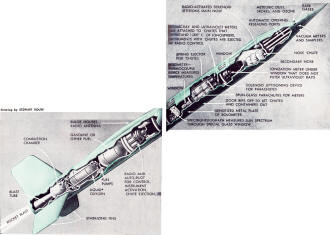
WAC Corporal sounding rocket drawing by Stewart Rouse
Above the 90-to-100 mile level, the super-rocket will bore into the F region,
which scientists believe to be the outermost ionized layer. During daylight, F consists
of two. layers, and the rocket will encounter first the F" or Appleton, layer, whose
lower limit averages about 100 miles of altitude. Beyond it, starting at 160 to
220 miles, depending upon the season, the rocket will penetrate F2, extending outward
to perhaps 500 miles. At night, the two layers merge into a single belt whose lower
surface is about 170 miles up. At this altitude, the atmosphere is so rare that
recombination of ions and free electrons takes place slowly, leaving sufficient
ionization during darkness to reflect the short-wave transmissions of more than
1,500 kilocycles that pass through the lower ionized layers.
Beyond the F region, where the temperature may rise to 1,000° C., the rocket
will find incredible cold and silence. The temperature in that stellar space, scientists
believe, is always -459°F., the "absolute zero" at which all molecular motion
ceases and through which only things that need no conducting medium may pass.
Already the outermost limits of the ionosphere have been left behind by high-frequency
radio waves, including those of the ionosphere recorder and the famous "moon radar."
One of the most significant features of radar contact with the moon, incidentally,
was its demonstration that the ionosphere can be penetrated from the outside by
radio waves. This has stimulated research regarding proposals to "bounce" signals
off the moon from one city to another on earth.
The sounding rockets, with their unprecedented vertical range, should reveal
much about the nature of the ionosphere as a shield protecting the earth from the
intense bombardment from outer space. The filtering action of the ionized layers
on external radiation is believed to be similar to that affecting radio waves from
the earth. Certain of the cosmic radiations are absorbed or reflected by the F and
E layers, while others are able to penetrate only in quantities harmless or beneficial
to life. Cosmic rays, which may have some influence on life by disturbing hereditary
factors in organisms, arrive from unknown distances with force enough to penetrate
the ionosphere, but even they are filtered to the point of safety.
Periodically, the ionosphere is disturbed by tremendous magnetic storms. During
these cycles, scientists have discovered, there is actual contact between the earth
and the sun, which sprays forth great streams of charged particles that reach the
earth's outer atmosphere in about 30 hours. The electron stream is believed to gain
its terrific velocity from a powerful magnetic field around the gaseous whirlpools
sometimes visible as sunspots. The additional ionization caused by these particles
in the ionosphere is believed to be the reason for the spectacular aurora borealis
and its southern companion, the aurora australis. The sensitive ionization meters
in sounding rockets sent aloft during such magnetic storms may record the exact
degree of added electronic activity and disclose for the first time the mysterious
nature of the aurora.
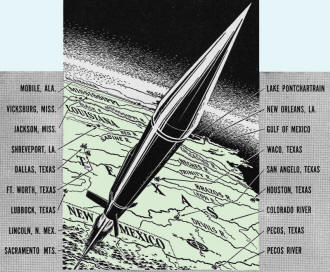 Analysis of the auroral colors already made
from the ground indicates electrical discharges in oxygen and nitrogen particles
as the cause of the fireworks, which reach down into the D layer and rise as high
as 250 miles. The aurora borealis, incidentally, has shown an unusual shade of green
which was once thought to represent a new element. However, this has been positively
identified as a radiation from atomic oxygen, this particular color occurring only
in the relatively undisturbed conditions characteristic of the outermost portions
of the earth's atmosphere. Analysis of the auroral colors already made
from the ground indicates electrical discharges in oxygen and nitrogen particles
as the cause of the fireworks, which reach down into the D layer and rise as high
as 250 miles. The aurora borealis, incidentally, has shown an unusual shade of green
which was once thought to represent a new element. However, this has been positively
identified as a radiation from atomic oxygen, this particular color occurring only
in the relatively undisturbed conditions characteristic of the outermost portions
of the earth's atmosphere.
Another important mission of the sounding rockets will be to measure temperatures
at various levels. Estimates of atmospheric structure already have been made under
laboratory conditions, but the scientists are anxious to check their results against
precise measurements by instruments borne into the upper air.
Whether the rockets will provide the answers to all of the mysteries remains
to be seen, but science is placing great faith in them. Work continues at the Jet
Propulsion Laboratory at California Institute of Technology, where civilian specialists
and Army ordnance experts developed the Wac Corporal and her secret sisters as a
part of the "Ordcit," (Ordnance-California Institute of Technology) program under
the general direction of Dr. Theodore von Karmen, aided by Col. B. S. Mesick. The
aviation industry is involved in the picture, too, for the Corporal was constructed
at the Douglas Aircraft Company plant in Santa Monica, California.
The assault on the ionosphere does not depend on the rockets alone. Intensive
research into ionospheric phenomena is under way in earth-bound laboratories, including
the Interservice Radio Propagation Laboratory at the National Bureau of Standards
in Washington, Harvard University's Cruft Laboratory, the Cosmic Ray and Radiation
Laboratory of Massachusetts Institute of Technology, the laboratories of the Department
of Research in Terrestrial Magnetism at the Carnegie Institution of Washington,
and in laboratories in England, Canada and Australia. The Army already is operating
a world network of observation posts established during the war to study ionospheric
conditions for the benefit of long-range radio communication. Science has just started
going "out of this world" to probe the make-up of the heavens.
Posted November 15, 2023
|










